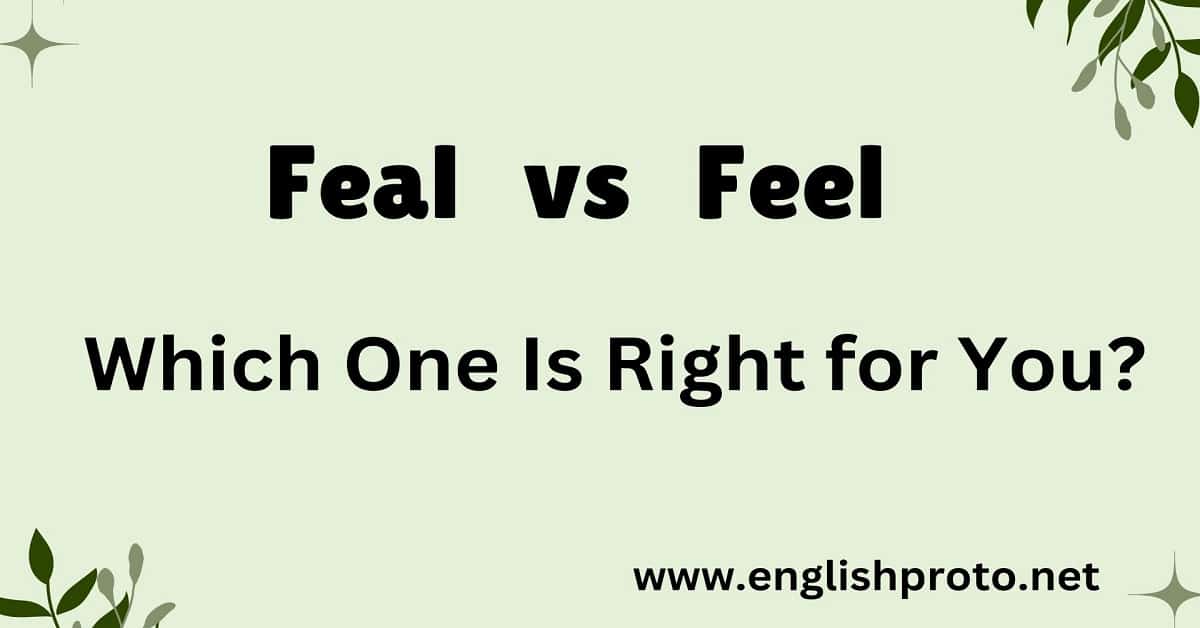Feal vs Feel: Which One Is Right for You? two words that sound alike but carry vastly different meanings. Have you ever found yourself wondering which one is correct when expressing emotions or sensations? You’re not alone.
This common confusion can trip up even the most seasoned writers. Whether you’re drafting an email, working on a professional document, or simply writing a blog post, understanding the subtle distinction between “feal” and “feel” can make a world of difference in ensuring your message is clear and precise.
Ready to dive in and master the right usage? Let’s explore why this seemingly small difference matters and how you can effortlessly use “feel” with confidence!
Quick Summary: Feal vs Feel
“Feel” is a verb used to describe the perception of touch or to express emotions and experiences. It plays a critical role in communication by allowing people to describe sensations, judgments, and emotional states.
On the other hand, “feal” is not a recognized word in English. It lacks a standard definition and has no practical use in professional or casual contexts.
Key Takeaways
- Feel is correct when describing sensations, emotions, and experiences.
- Feal is incorrect and should be avoided in both written and spoken language.
- Properly distinguishing between the two improves communication clarity.
Reasons for Confusion
The confusion between feal and feel often stems from several factors:
Pronunciation Similarity
Both “feal” and “feel” are pronounced exactly the same, making it easy for people to overlook the correct spelling. When spoken, they sound identical, which can lead to mistakes in writing, especially in fast-paced or informal communication.
This phonetic similarity often causes individuals to accidentally use the incorrect term, believing that “feal” might be an alternative spelling.
Spelling Variations
The resemblance between feal and feel is deceptive because they share similar letters, making feal seem like a plausible alternative. People might unintentionally type feal due to their fingers resting on the wrong keys or due to the influence of other similar-sounding words like “deal,” “seal,” or even the non-standard use of suffixes like “-real.”
Regional Influences
In some regions, the pronunciation or spelling variations may not be as strictly monitored, which can contribute to the confusion. For example, non-standard pronunciations or local dialects might obscure the differences between these terms. This is especially common in informal communication, where rules of grammar may be relaxed.
Detailed Explanation: Feal vs Feel
Correct Usage of “Feel“
“Feel” is a fundamental verb in the English language, encompassing a variety of meanings. Below, we’ll break down its usage and why it is the preferred term.
1. Physical Sensation
One of the most common uses of “feel” is when describing physical sensations:
- Meaning: To perceive something through touch or sense.
- Example: “I can feel the texture of this fabric.”
This use applies to any form of sensory perception—be it through touch, temperature, or other physical sensations. Whether someone is describing how something feels against the skin or how something feels underfoot, “feel” is the correct verb.
2. Emotional or Psychological Sensation
Beyond physical sensations, “feel” is widely used to express emotions or states of mind:
- Meaning: To experience or be affected by emotions, thoughts, or moods.
- Example: “I feel anxious about the upcoming deadline.”
Using “feel” to convey emotional experiences is essential for empathetic and personal communication. It allows individuals to articulate complex emotional states that cannot be adequately expressed by simpler terms.
3. Intuitive Understanding
“Feel” can also be used to describe an intuitive grasp of situations or concepts:
- Meaning: To perceive, understand, or sense something instinctively.
- Example: “I feel that the proposal is worth pursuing.”
In this context, feel doesn’t rely solely on sensory perception but integrates reasoning and personal insight. This usage is essential for expressing subtle judgments or beliefs where emotional intelligence plays a part.
Common Errors
Despite its clear and established usage, many people mistakenly use “feal.” Below are some examples of why this should be avoided:
- Feal: “I feal the warmth.”
Correct: “I feel the warmth.”
Here, “feal” is an incorrect substitution that adds no real meaning to the sentence. - Feeling: Sometimes, people mistakenly use “feeling” where “feel” is the correct form.
Example: “I am feeling tired.”
Correct: “I feel tired.”
Errors like these dilute the clarity of communication, making sentences harder to comprehend. Avoiding these mistakes enhances both personal and professional writing.
Synonyms or Alternatives
Although “feel” is a robust and versatile verb, there are other terms that can be used in different contexts. Below are a few suitable alternatives:
- Sense:
Used for physical perceptions.
Example: “I sense a change in the atmosphere.” - Experience:
Applied for personal encounters or emotional experiences.
Example: “I experienced joy after achieving my goal.” - Perceive:
Used for intuitive understanding.
Example: “I perceive the subtle changes in his expression.”
Examples in Sentences
Here are more detailed examples showcasing the correct use of “feel”:
- Correct Usage:
- “I feel the warmth of the sun on my skin.”
- “She can feel the excitement of the crowd during the event.”
- “He doesn’t feel comfortable speaking in front of large audiences.”
- Incorrect Usage:
- “I feal the cool breeze.”
- Correct: “I feel the cool breeze.”
- “I feal the cool breeze.”
These examples emphasize how “feel” should be used in everyday language.
Origins and History
The word feel has its roots in Old English, derived from the term feallan, which meant “to grasp” or “to touch.” Over the centuries, its usage evolved to encompass both physical and emotional meanings. While the term has undergone slight transformations over time, its core usage has remained consistent.
Conclusion: Feal vs Feel
In summary, understanding the distinction between “feal” and “feel” is crucial for clear and effective communication. Feel is a well-established and versatile verb used to describe sensations, emotions, and intuitive understanding.
Conversely, feal is not a recognized word and should be avoided in both written and spoken contexts. By maintaining the correct usage of “feel”, writers and speakers can enhance the professionalism and clarity of their messages.
Whether in academic, professional, or casual settings, precise word choice strengthens communication and fosters better understanding.



